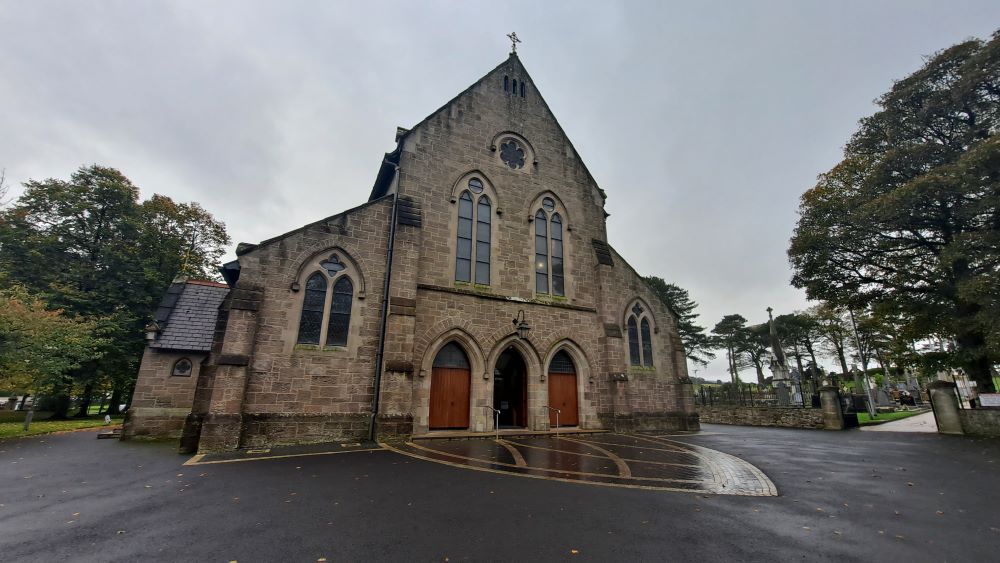Fr Patrick McKeefry and St Patrick's Church Dungiven
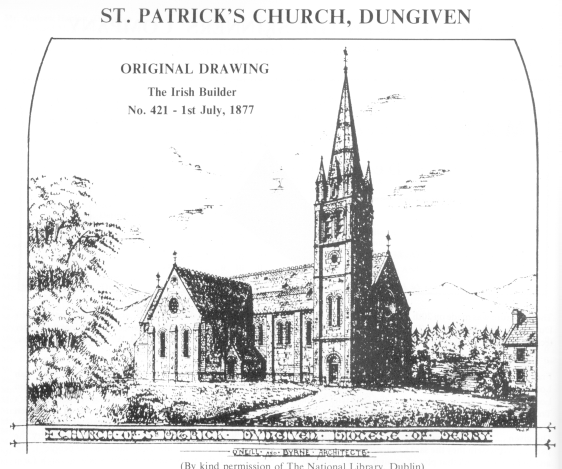
SAINT PATRICK'S CHURCH, DUNGIVEN
The architects here are O'Neill and Byrne, Dublin. However, the architects who actually built the present church were O'Neill and McCarthy, Belfast and Dublin. Mr O'Neill died during construction and the actual work was done principally by Mr. Mortimer H. Thomson of Belfast.
WHOSE PLAN?
Whose idea was the above design with its manifest beauty and symmetry? Father Tracy's? Or Father Mooney's? The date, 1st July, 1877, falls within Father Tracy's term as P.P. But Father Mooney was alive until 24th April, 1876. He had already acquired the site and was planning to build a church. His death at the age of 63 would have left unfinished work.
The tower which is a gem, and the substantial annex facing the roadway are of great interest. As is the somewhat remote location of the parochial house. The Irish Builder contains no drawings of St Patrick's Church later than the above in 1877. A disappointment, naturally, in view of the drastic change of plan.
TOWER AND BELL
The dream of a tower persisted long after it was dropped from the original plan. The most active visionary was Father Patrick McKeefrey, P.P. 1926-38. With the parochial house built (1929) and little financial stress from schools, the tower and bell fund became a dominant parish charity. One did not need to be particularly affluent to be accosted on the street by Father McKeefrey. A contribution for the tower and bell!
Mrs. Annie Boyle of Priory Road recalls her youthful activities around Drumsurn as one of Father McKeefrey's fund-raisers. In the late 1920's and early 1930's, she remembers, Father McKeefrey made a special effort to raise money to plaster Drumsurn chapel inside and out, and to provide a tower and bell for the church at Dungiven
AUTOGRAPH QUILT
His fund-raising methods, says Mrs. Boyle, were novel. Mostly he had two-penny raffles. Nothing, at any rate, was over sixpence. The schoolchildren got sheets of paper and were asked to get people to contribute: "Please contribute" 6d. and your autograph to the Autograph Quilt". The children dreaded the task of going to the houses with the tickets. It was a patch work quilt. When hundreds of names has been contributed the quilt was raffled. We do not know who won the quilt. The children went round the whole community, Catholic and Protestant, and everyone eagerly contributed.
Another of Father McKeefrey's ideas was his "Stop-Watch Competition". A man's pocket watch was wound up and started and placed in a box which was then sealed. You paid sixpence for a guess as to what time the watch would stop. And there were his Concerts. Father McKeefrey himself sat on the stage. Some brave soul from the audience would ascend the steps and whisper mysteriously in his ear. Father McKeefrey would then announce benignly that Margaret McCloskey - or whoever - from down the floor, would sing a song. And the night wore merrily on. Then when St Patrick's Day came, he would have the children selling Patrick's Day badges for 2d. each. One thing for certain when Father McKeefrey delved into the inside pocket of his overcoat, one knew there was always a bundle of 2d. tickets coming up for sale.
FATE OF THE TOWER
What then happened to the tower? His Lordship the bishop, Dr. Daly has kindly filled in the picture from a document which he possesses. Around May 1932 Father McKeefry requested Mr. J. P. McGrath, architect, Derry to prepare plans for a tower for Dungiven Church. The cost was not to exceed £1,000 (Fr. McKeefrey stating that even that amount would be difficult to raise).
Mr. McGrath prepared successively two sets of plans apparently changing the site of the tower in doing so. The lowest tender for the plans, however, was £5,600. Fr McKeefrey then claimed that his instructions regarding cost had been ignored. He could not get involved in such an expensive venture. Accordingly, with the apparent approval of the bishop, Dr. O'Kane, the project of the tower was abandoned. The date of the document in possession of Daly is October, 1936.
Fr. McKeefrey's enthusiasm may have stemmed from an acquaintance with the 1877 plan reproduced here, although his £1,000 tower would clearly have been inferior to the one in the drawing. He would also have been aware of the fact that Dr. O'Brien P. P., Limavady had built the tower of St. Mary's a full sixty years after the Church was built.
THE BELL
The erection of the bell on its present graveyard site in 1934 suggests that the tower project had even then been abandoned. Temporarily, at least. Some day perhaps the bell would find a proper home. But, as Vincent Kealey recalls in his article, Fr. Frank Doherty said simply: "There she is, and there she'll stay".
"She" was given a nice Latin christening: Ecclesia de Dungiven. Sancte Patritii ora pro nobis. (Latin purists might quibble about that word Patritii). Above the Latin are names of the makers and the date, Gillett and Johnston 1934.
The bell began its days with sound and flourish - through town and country-side. Today the bell lies silent.
SAINTLY PRIEST
The centenary brings the tower to the fore. And the tower brings Father McKeefrey to the fore. The tall gaunt figure with the ascetic bearing must remain a fascinating memory to those growing up in the 1930's. Memories of one's first parish priest endure. Like that of his Friday school visit. Invariably he opened by asking about the previous Sunday sermon ... What was Fr. McKeefrey's sermon about - nearly a week before? Here was a poser for a roomful of nine to thirteen year olds. A boy would then be called up to read the Gospel. Sweetness and light, thereafter.
For an austere, aged man, Fr. McKeefrey always remained very close to children. Not just in the ticket-selling sense, which Mrs. Boyle pleasantly recalls. But in the things of the spirit. On first Saturdays he always said the children's Mass himself. And gathered us into the front seats for an after-Mass talk, when the grown-ups had left. We shouldn't throw stones on that special day (Innocent Age, 1935!) All should behave in such a way that everyone would say: "Those children are all very good today. They must all have received Holy Communion this morning". (His exact words, month after month).
Adults of those days had their own memories. Like the bare boards of Holy Poverty on the night of his wake, January, 1938. A good enough assessment of Fr. McKeefrey's impact on parish life was the rumour doing the rounds some years after his death. "They're going to dig up Fr. McKeefrey to see if he was a saint". Hardly the perfect canonical approach for canonisation. But still an earthy, rough and ready reaction to what is called priestly holiness. Which is hard enough to come by. Even by rumour.
The above extract about Father Patrick McKeefry is taken from the excellent publication, "Benbradagh" Christmas 1984, No 14. The Centenary of St Patrick's Church occurred that year and the above was part of a section on it's history.
The Author is Seamus Hasson, Dungiven who kindly allowed the reproduction of this article.
I also wish to thank Brian Devenny, Co Tyrone, who kindly give me the photographs of Father McKeefry which I used on these website pages.
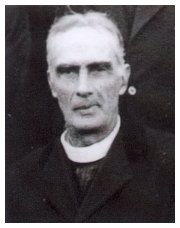
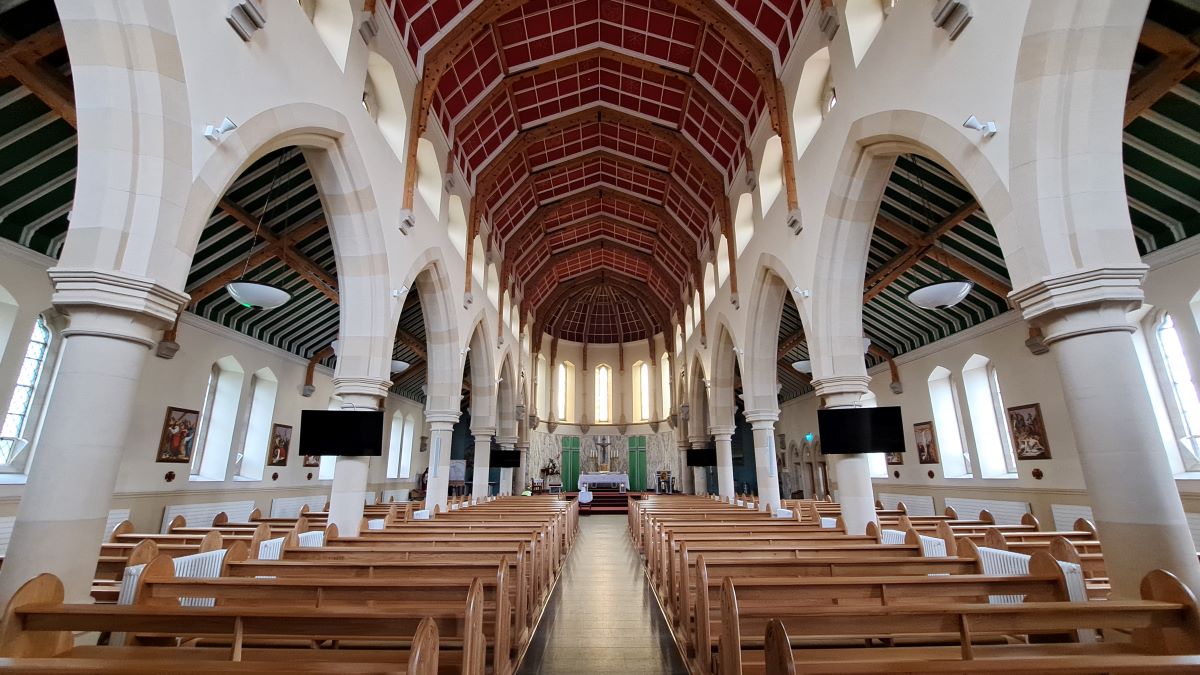
Photo below 1999
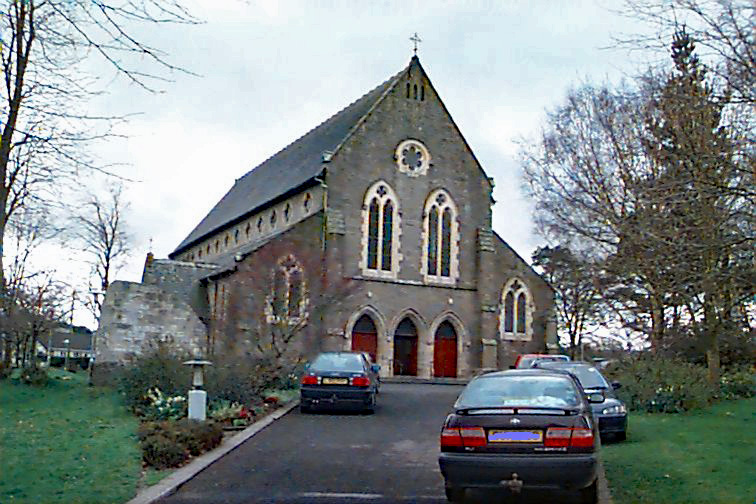
Click here to return to McKeefry Priests page













